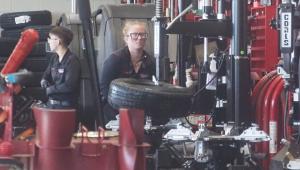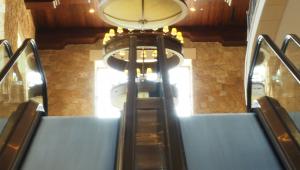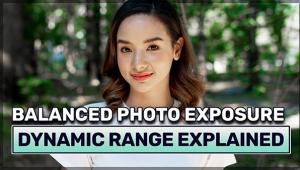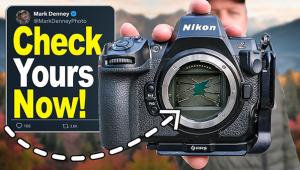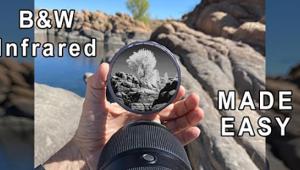Is “7” The Megapixel Lucky Number? ; We Put Seven Of Those 7-Megapixel Digicams To The Test
During 2004, most of the major camera manufacturers announced 8-megapixel digicams, leading us to believe that the next trend would bring 10-megapixel models in 2005. Instead, it brought a slew of new 7-megapixel cameras with built-in lenses. At press time, over a dozen such models were available. Meanwhile, it seemed that 8-megapixel development had ground to a halt, at least among the major companies.
 |
||
 |
 |
|
|
||
My inquiries as to the reasoning behind this produced no definitive answers.
However, I can think of several likely reasons that kept the 8-megapixel digicams
from becoming best sellers. Aside from the substantial size, weight, and price,
many potential buyers do not care for electronic viewfinders. Those are standard
in most of the cameras, necessary because of their long, built-in lenses. Serious
shooters often prefer digital SLRs instead. Another reason for the "8's"
decline could be the negative reviews that emphasized their narrow dynamic range
and prominent digital noise at high ISOs. (These are caused by cramming too
many miniscule photodiodes on a tiny CCD chip.)
In any event, the 7-megapixel models are quite different. They employ the same
size CCD sensor with a million fewer photodiodes for slightly better image quality
at ISO 400. Their bodies are smaller and lighter; some are tiny featherweights
by comparison. They incorporate optical viewfinders, although some are miniscule,
a price we pay for ultra-compact size. Prices are also lower, with some available
at under $450. Although their shorter optical zooms are not as versatile, the
full-featured
7-megapixel models are competitive in other specifications.
In order to get a feel for the 7-megapixel category, we decided to test seven
models, ranging from ultra compact to the prosumer level. These cameras are
quite different in many respects, including their target market and feature
set. Some are intended as digicams for families while others are loaded with
advanced capabilities for photo enthusiasts. In order to avoid an "apples
to oranges" comparison, I tried not to pit one type directly against another.
 |
||
 |
 |
|
 |
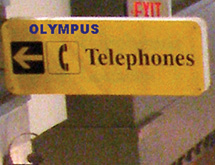 |
|
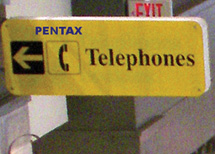 |
 |
|
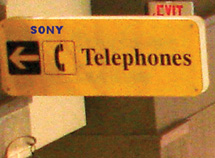 |
||
|
||
Test Procedure
Although the seven cameras were not available at the same time, I was able to
find certain subjects that I could shoot in virtually identical conditions,
returning to the locations when another camera arrived. I also recruited a panel
of "evaluators": six potential digicam buyers ranging in age from
19 to 40+. This group offered comments on styling, responsiveness, and convenience
of operation.
Because all of the contenders employ a 7-megapixel (1/1.8") CCD sensor,
resolution is virtually identical. The primary differences are created by lens
quality and each company's processing and other systems. Our Evaluation
chart provides a convenient overview of the merits of each of the cameras. For
the sake of consistency, all of the comments are based on
full-resolution images made at the best JPEG quality level using default settings
for exposure, color, white balance, contrast, sharpness, etc. Even better results
are often possible when using the in camera overrides or the anti-redeye flash
mode.
G6 Features |
|
 |
|
|
Canon PowerShot G6
One of three 7-megapixel models in the PowerShot line, the G6 is the largest
and most sophisticated of the trio. This is a prosumer camera with a tilt/swivel
monitor, very fast (wide aperture) zoom, and many of the capabilities we expect
in a digital SLR. These include a Raw Capture mode, convenient manual focus,
numerous modes and overrides plus compatibility with accessories: EX-series
flash units as well as filters and lens converters (using an adapter kit). Granted,
it's a bit pricey
when compared to some of the others in this review.
Evaluation: Our panel of potential buyers was not happy with
the size or weight, but all appreciated the flip-out/rotating LCD monitor. "It's
also easy to use until you wonder what all the extra features are for,"
one commented. The female panelists were not impressed with the styling but
the guys felt it was a great-looking camera. And yes, the many capabilities
do require a study of the Owners Manual, but the G6 will not intimidate experienced
digital shooters. In my estimation, it's more convenient to use overall
than many other prosumer models, thanks to a nearly perfect analog control layout
and menu.
In outdoor shooting, this camera is fast and delivers consistently excellent
images with punchy color, good shadow detail, accurate exposure, and white balance.
It's just about perfect in flash photography as well. The default level
for sharpness is way too low and most owners will want to select a higher setting,
in camera. Photos made at ISO 400 are highly acceptable because of a fine, tight
noise pattern; the noise reduction processing is not aggressive so the images
look natural.
Most photographers who already own a digital SLR camera would probably prefer
one of the more compact models as a "take anywhere, shoot anytime"
digicam. Personally, I would learn to live with the greater size/weight, because
overall, the Canon PowerShot G6 was my favorite for serious photography. And
if forced to give up my digital SLR system, this is the 7-megapixel camera that
I'd want as an alternative.
EX-Z750 Features |
|
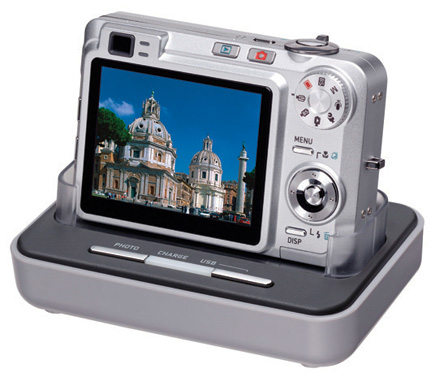 |
|
|
Casio EXILIM ZOOM EX-Z750
Casio is becoming a strong contender in the high-resolution market with two
7-megapixel digicams, including this tiny model with an oversized 2.5"
LCD monitor. Thanks to advanced miniaturization technology, the EX-Z750 is super
slim (0.88" thick) but full featured. Valuable amenities include a live
histogram, manual focus, a full range of operating modes from Automatic to Manual,
and all of the essential overrides. It's very responsive, too, taking
a shot almost instantly even in low light, great for candid picture taking.
Evaluation: This small silver camera was the hands-down winner
among the panel for its form factor, oversized LCD monitor, and unusually quick
response. Even the traditionalist in the group loved the styling. The panel
was less impressed with the tiny external controls and icons but praised the
logical, easy to read menu, especially when selecting one of the numerous subject-specific
Scene modes. Operation in Manual and Semiautomatic modes was far from intuitive
but I agreed that the camera was quite easy and convenient to use overall.
Although not perfect, the Casio EXILIM ZOOM EX-Z750 is certainly desirable in
most respects, as indicated in our chart. Especially outdoors, it produces very
pleasing photos; the low sharpness is fine for portraits but can be boosted
in camera when desired. The warm color balance in flash photography can be corrected
in Photoshop or other software. This camera is well equipped for both snapshooting
and some serious photography, although a wider range of f/stops and faster image
recording would make it even more suitable. If I needed a very small digicam,
this one would be my first choice of the models tested.
Coolpix 7900 Features |
|
 |
|
|
- Log in or register to post comments












